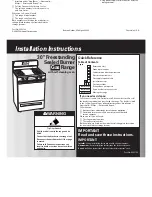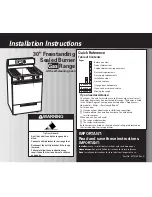
OPERATION INSTRUCTIONS
USING THE OVEN FOR BAKING OR ROASTING
To avoid possible burns, place the shelves in the desired position before you turn the oven on.
HOW TO SET YOUR OVEN FOR BAKING OR ROASTING
1. Position the shelf or shelves in the oven. If cooking on two shelves at the same time, stagger the pans for best heat
circulation.
2. Close oven door. Turn OVEN TEMP knob clockwise to desired temperature. Preheat oven for at least 10 minutes if
preheating is necessary.
3. Place food in oven on center of shelf. Allow at least 2 inches between edge of bake ware and oven wall or adjacent
cookware.
4. Check the food to see if it is done at the minimum time on the recipe. Cook longer if necessary. Turn OVEN TEMP
knob to OFF and remove the food.
SHELF POSITIONS
•
Most baking is done on the second shelf position (B) or the third shelf positon (C) from the bottom.
•
When baking 3 or 4 items, use two shelves positioned on the second and fourth sets of supports (B & D) from the
bottom of the oven.
•
Bake angel food cakes on the fi rst shelf position (A) from the bottom of the oven.
•
Roasting is usually done on the bottom shelf position (A).
PREHEATING
•
Preheating the oven takes about 10 minutes.
•
Preheat the oven only when necessary, usually for baking.
•
Most roasts will cook satisfactorily without preheating.
• If
you
fi nd preheating is necessary, keep an eye on the Oven Cycle light and put food in the oven promptly after the
light goes out. The oven cycle light will then cycle on and off with the oven thermostat as it cycles to maintain the oven
temperature.
•
Follow a tested recipe and measure the ingredients carefully. If you are using a package mix, follow label directions.
•
Do not open the oven door during a baking operation - heat will be lost and the baking time might need to be
extended. This could cause poor baking results. If you must open the door, open it partially - only 3 or 4 inches - and
close it as quickly as possible.
•
Roasting is cooking by dry heat. Tender meat or poultry can be roasted uncovered in your oven. Roasting
temperatures, which should be low and steady, keep spattering to a minimum. When roasting, it is not necessary to
sear, baste, cover, or add water to your meat.
•
Frozen roasts of beef, pork, lamb, etc., can be started without thawing, but allow 10 to 25 minutes of additional time
per pound of meat (10 minutes per pound for roasts under 5 pounds, more time for larger roasts).
•
Thaw most frozen poultry before roasting to ensure even cooking. Some commercial frozen poultry can be cooked
successfully without thawing. Follow directions given on package label.
BAKING AND ROASTING TIPS
9












































